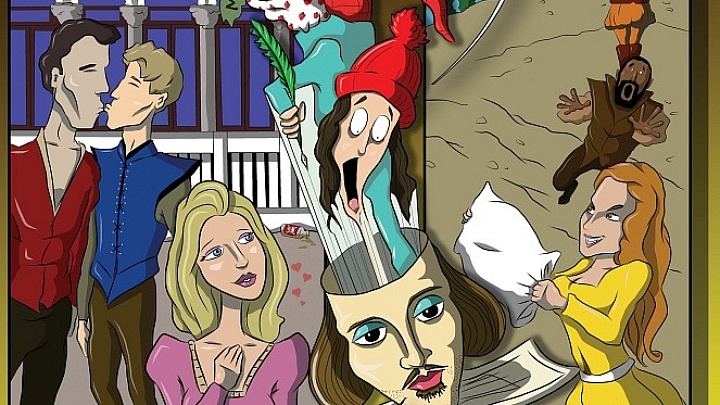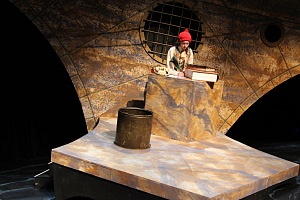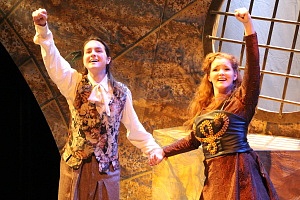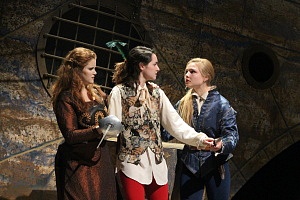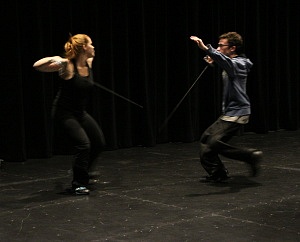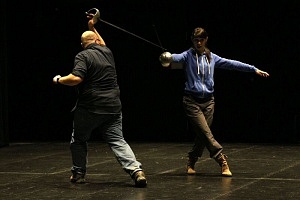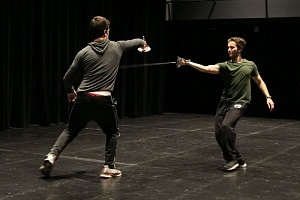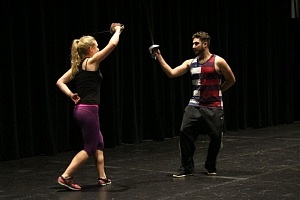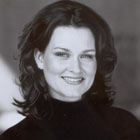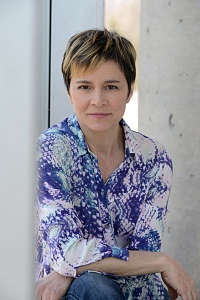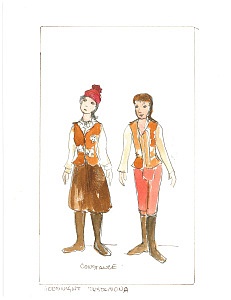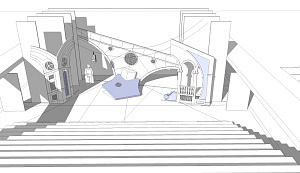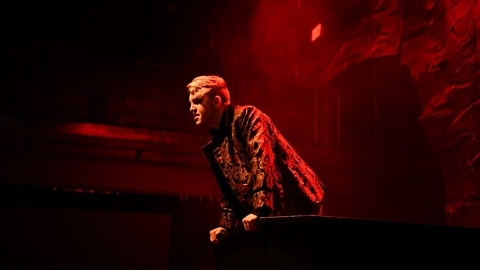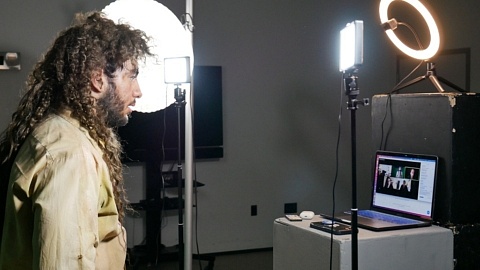For nearly two years, theatre lovers have felt entrapped in their own little purgatories. Artists have been unable to perform on stages, and audiences been...
By DART Critics
March 2, 2016
Linda Duong, Brendan Farley, Chloe Lemay, Kaitlin Morrison, Rachelle Scott, and Demetri Tsioros write: We started with a meeting with director Danielle Wilson and have observed fight intensives and fight choreography with Jamie Treschak. Now, in our last posting, we, the six embedders in Good Night Desdemona, (Good Morning Juliet) (GNDGMJ) present you with discoveries from the Tech Dress Rehearsal and the Final Dress Rehearsal for the production, which we observed in two groups. Final notes were discussed, props were set, and everyone who’s been a part of the process got to revel in all their hard work being put into action.
February 24th, 2016 (Rachelle and Brendan): As we walked into the theatre at 7:00 pm, the place was full of hustle and bustle: assistant director Mark Harrigan directed the stagehands where to place props on the centre piece of the set; different sounds and lighting were being tested; and the cast ran through small snippets of scenes while director Danielle continued to side coach. The crew for GNDGMJ consists of second year DART students who helped build the set and costumes and who will operate the sound and lighting for the production as well as serve as the running crew back- and onstage. The actors also ran through their fight choreography in order to ensure safety and refresh their memory, with Mark supervising. Before a scene ran, Mark would call out, “fight on stage!” so that everyone was aware that fighting was happening, and to be sure to stay out of the way.
At 7:30 pm, stage manager Oriana Marrone called everyone to their place, sitting in her booth with Danielle by her side. In the audience, the rest of the design team including Kelly Wolf (costume), Gavin Fearon (sound), and Yasmine Kandil (lighting) were present. A Tech Dress rehearsal for a production is a run-through with full costumes and sets. It allows the design team and the director opportunities to make any notes about issues that need fixing, such as costume malfunctions or the timing of scene changes.
The run went very smoothly, with very few stops (one happened when Jeremy Knapton, who plays Iago and the Ghost, needed to adjust his sword holster). The cast was fully committed to their roles, displaying lots of energy and enthusiasm. Raylene Turner especially showcased the awkward charm that brings Constance to life. We, as well as the rest of the crew, had tons of fun laughing along with the production, especially at funny moments like cross-dressing scenes with Josh Sanger as Juliet’s Nurse and Robert Herr as “Romiet” wearing a dress. We both agreed that the soundtrack was well chosen, including many popular and catchy tunes. Intermission was allotted 10 minutes, and the play finished just before 10 pm. After much applause, the crew met with Danielle and the designers to go over notes. Danielle summed up the night with the best phrase possible: “That was one hell of a Tech Dress!”
February 25th, 2016 (Linda Duong, Chloe Lemay, Kaitlin Morrison, and Demetri Tsiros): Coming into the Final Dress, we were very excited to see how the production had come together. We noticed how detailed the set was, creating simultaneously the space of Constance’s office and the two Shakespearian locations – Cyprus and Verona. The off-balance tilt of the set originally sketched in Nigel Scott’s design captures the chaos and confusion that Danielle wants to suggest, representing Constance’s state of mind. All of the drawings and sketches that we saw in our first meeting with Danielle had jumped out of the pages and onto the stage.
A Final Dress rehearsal is similar to a Tech Dress in the sense that the entire cast and crew are present and fullly costumed; this run is treated as if it were opening night, with no stopping. The show is timed and the expectation is that changes requested during the tech dress have been made. The lights dimmed, and we were excited to finally be witnessing GNDGMJ in its entirety!
The work the actors had put into their characters was clear, with, amongst others, Raylene Turner displaying her commitment to Constance’s funny, bookworm antics and Robert Herr playing the very melodramatic Romeo who can’t help but fall in love with one person after another. The sword fighting and stage combat had improved significantly since the first rehearsal we observed; it now had ease, speed and technique. The “warp” scenes between the play’s different worlds that had prompted questions of “how are we going to do that?” now included lighting, smoke and video projections that are subtle but very effective. Actors also used the garbage can trap-door for entrances and exits very effectively, making diving into a bin look effortless.
To conclude: It has been an incredible journey being able to embed behind the scenes of GNDGMJ. Through our five visits, we got to witness just how much work, thought, and preparation goes into making a production. Danielle Wilson and the rest of the cast and crew invited us into their space with open arms, creating a safe and fun environment for everyone to make new discoveries, while we got the special opportunity to document it all.
So folks, the paint has dried, the lighting has been hung, and the stage is set! Go see for yourselves what a brilliant engaging and hilarious production GNDGMJ has come to be! Take it from us that you surely will want to go see it again and again and invite all of your friends and family!
The production’s remaining performances are on March 4 at 11:30 and 7:30 pm and March 5 at 7:30 pm, in the Dramatic Arts Theatre at 15 Artists’ Common.
February 14, 2016
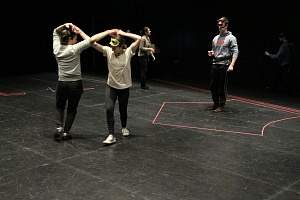
Robert Herr (Romeo), Raylene Turner (Constance), Alex Tomelescu (Mercutio), and Josh Sanger (Tybalt). Photos by David Vivian
Linda Duong, Brendan Farley, Chloe Lemay, Kaitlin Morrison, Rachelle Scott, and Demetri Tsiros write: The six embedders of Good Night Desdemona, (Good Morning Juliet) (GNDGMJ) are behind the scenes once again. This time we’re witnessing what goes on during a rehearsal without Jamie Treschak, the fight director, present. We broke into two groups and were treated to two sessions with Danielle Wilson, where she “side coached” (or in other words, provided direction during scenes) her cast as they progressed further into the process of discovering characters, actions, and intentions. Danielle’s rehearsals were very well-organized and structured, calling actors into rehearsal for specific times as needed.
January 25th, 2016: (Rachelle, Kaitlyn and Demetri) Rehearsal was in the evening in the DART Theatre from 6 to 9 p.m. Present were Danielle, assistant director Mark Harrigan, assistant stage manager Elena Milenkovska, Robert Herr (Romeo), Elizabeth Amos (Juliet), and Raylene Turner (Constance). Before working with the actors, Mark and Danielle discussed where the garbage can that sucks Constance into the Shakespearean world will be placed. For the first hour, Robert was off to the side concentrating on personal work while Raylene and Elizabeh rehearsed Act 3 Scene 5, in which Juliet is disguised as Romeo delivering his lines to Constance on the balcony, performing a parody of the famous scene from Romeo and Juliet.
All of us had a great chuckle at the scene because of Ann Marie MacDonald’s witty writing — Constance’s trip to Verona leads to countless shenanigans around false identities and cross-dressing with the star-crossed lovers. For the rest of the evening, the company then rehearsed the previous scene (Act 3 Scene 4), where Constance crashes a masked ball hosted by Juliet’s father and a love triangle ensues between her, Romeo, and Juliet. Josh Sanger (Tybalt) arrived before the last hour to play the second half of the scene, in which Romeo tries on a skirt in hopes of disguising himself as a woman to pique Constance’s lust. Midway through, the department’s head of wardrobe Roberta Doylend surprised everyone with a showcase of finished props and masks, some of which were quite playful and some disgusting (an appendix in a jar!).
The rest of the rehearsal consisted of, first of all, the actors recording dialogue on an iPad, with Elena, the ASM, handling the technical side as Mark read out stage directions for the actors. This recording was then used as the actors ran through blocking in mute as the recording played. The three of us have previously completed a semester studying Shakespeare’s texts in performance with Danielle and are thus familiar with this technique. She uses it to help her actors play with physicality – they can experiment with blocking and discover any uncertainties in their performances. They repeated this multiple times and we witnessed, in a short period of time, a huge improvement. The actors began displaying clearer intentions and reactions; they were more playful and risk-taking and went big, physically. Through this exercise we gained a greater sense of the cast’s presence on the stage and got a taste of the high energy audiences will soon be witnessing.
January 28th, 2016: (Linda, Chloe and Brendan) At this rehearsal, Danielle, Mark and Elena were present as well as stage manager Oriana Marrone. The cast members called for the beginning of this rehearsal were Raylene and Jeremy Knapton (Iago/Ghost). We noticed from the beginning that the cast was starting to make more use of the centre platform on stage. They noted the hole for the garbage bin that would soon be cut out of the stage, and began to block their scene around it. We saw Danielle actively directing actors and noted how she frames specific moments on stage, always paying attention to spatial relations. More pieces of the set were also becoming available for the cast to practice with. Danielle noted that by the 30th (two days from that rehearsal), they would have worked on every scene in the play.
A majority of this rehearsal was focused on Act 3 Scene 6 in which Constance encounters a ghost similar to the one in Shakespeare’s Hamlet. Constance repeatedly fails to understand the ghost’s allusive responses to her questions about the “wise fool” she believes is missing from Shakespeare’s tragedies. After Constance’s short conversation with the stand-up comic of a ghost as played by Jeremy, Tybalt barges in and forces her to a swordfight. They then shifted to Act 3 Scenes 8 and 9 as Constance thwarts Tybalt’s challenge and the play reaches its conclusion. We’d tell you all the details — but we wouldn’t want to give away the ending!
As this session began, Danielle and Mark listened to the actors read through the scene before going through the blocking, while, as in the previous rehearsal, recording the scene’s dialogue onto an iPad. Afterwards, they talked through the scene, addressing questions and concerns, occasionally altering blocking on the spot. The actors then walked through their blocking while playing the recording to let the movements sink into their bodies. Danielle will often do this for her actors to discover and play with the character as they’re still unearthing their relationship and circumstances. Jeremy dove into the scene with an amazing vocal presence, learning consistently as he went.
Midway, Josh, Elizabeth, Robert and Katelyn Lander (Desdemona) arrived to rehearse the final scenes with Raylene; as Jeremy ran off for a fitting, Robert put on a skirt and sword. At this point Danielle became more interactive and physical with her cast. She worked through character motives and blocked out her vision for the conclusion of this story, with Mark helping her guide the actors as they worked.
Between the two rehearsals we always saw the actors having fun — which is an important feature of the environment Danielle creates. The company has become very focused and hardly ever strays off track, with constant peals of laughter ringing throughout the theatre. They’ve even become more comfortable in their use of swords!
February 11, 2016
Linda Duong, Brendan Farley, Chloe Lemay, Kaitlin Morrison, Rachelle Scott, and Demetri Tsiros write: As the next step in our embedding, we had the pleasure of viewing the fight choreography for Goodnight Desdemona (Good Morning Juliet). We split up into two groups and attended two separate rehearsals. Jamie Treschak joined the cast on both occasions to go over sequences the cast had learned previously (in rehearsals we hadn’t attended), and to discuss how to progress further in the coming weeks. With director Danielle Wilson by his side, his prime objective for this process was to make sure that each actor was safe, comfortable, precise, and had intention in the scenes. Danielle’s role was to help everyone get into their characters as she urged them to relax, stretch, and mentally prepare to execute the daring fight scenes. During our two visits, in between the moments of play and laughter, we saw hard work and continuous repetition that captured the company’s artistic vision.
January 6th, 2016: We (Chloe, Linda, and Rachelle) were the embedders of the day and watched Danielle and Jamie create a collaborative atmosphere in which they reviewed safety rules, designed blocking, and worked to improve on the speed and rhythm of the choreography now that the cast had the swords they will use in performance. Jamie explained how timing helps everything look smooth, eases transitions, and sells the effect.
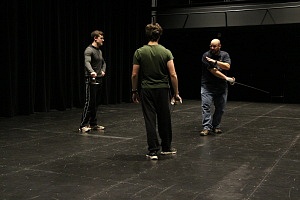
Josh Sanger (Tybalt) and Robert Herr (Romeo) receive instruction from Fight Director Jamie Treschak. Photo by David Vivian.
The scenes worked on that day involved Desdemona (Katelyn Lander), Constance (Raylene Turner), Iago (Jeremy Knapton), Juliet (Elizabeth Amos), Romeo (Robert Herr), Tybalt (Josh Sanger), and Mercutio (Alex Tomulescu). The first scene starts with Constance believing that Iago is trying to kill Desdemona, so she steps in to stop him, only to find out the sparring is friendly. The second scene has Constance stopping Juliet from killing herself, and then being confronted by Romeo and Tybalt after Juliet leaves. In the third scene Romeo and Tybalt fight for the second time in the play with Constance stopping Tybalt from killing Mercutio.
As each fight was performed, those who weren’t in the current scene went over their lines and reviewed their own choreography. Once they became comfortable with the moves, they began to speed up their fighting to ensure that they knew what they were doing, to review how fast the moves were, and to make sure that it looked believable as an entire choreography sequence.
The day was productive as the cast stayed focused as they worked on dialogue and choreography. If a problem arose, they were able to collectively work through it without wasting any time and had fun in the process. Jamie told the actors to connect their real life emotions to their characters in their fights to help further their character development, movements, and motives. Together, Danielle and Jamie furthered the production’s creative process, focusing on how the show will be perceived from the audience’s perspective.
January 23rd, 2016: Today we (Brendan, Kaitlin and Demetri) rolled up to the Dramatic Arts Theatre and watched the actors from Goodnight Desdemona (Good Morning Juliet) leap, parry, and thrust their way through another fight rehearsal.
Jamie guided Alex and Josh as they ran through their fight choreography at half speed. Once the scene was completely rehearsed, Robert joined, allowing Alex to run her lines while he and Josh began their fight. The two men worked on their fight choreography, finding ways to safely “inflict” fatal wounds on each other. Jamie reminded everyone that in order to make a fight believable there has to be “intention in the actions”, and that “you have to keep eye contact”. Once they finished, Jamie instructed the three actors to rehearse the entire scene together, bringing in Raylene to join the fight when her character, Constance, enters.
The rehearsal moved forward with Josh, Alex and Robert leaving and Jeremy and Katelyn joining Raylene for a run of their fight scenes. Jamie worked with the trio in order to perfect and safely choreograph the scene in which Constance sees Iago and Desdemona sparring. With precision, ensuring that each move had a clear intention, the three played their way through their scene.
As this session came to a close, Jamie informed the cast they had done very well but noted that they needed to continue to rehearse the choreography in their own time to keep it fresh. Danielle ended the night with notes for the actors and released them until next time.
January 24, 2016
Linda Duong, Brendan Farley, Chloe Lemay, Kaitlin Morrison, Rachelle Scott, and Demetri Tsiros write: We, the six embedders in Good Night Desdemona, (Good Morning Juliet) (GNDGMJ) continued our journey by entering the world of fight intensives. Director Danielle Wilson passed the torch to fight director Jamie Treschak for this part of the production process, which took place for two successive weekends in December. Here, each of us writes about our experience with the intensive. As it was open to Brock students not in the production, Demetri also got the chance to participate and work directly with Jamie, while the rest of us were observers on various days of the event.
Demetri Tsioros writes: This stage combat intensive involved skills in basic unarmed combat and rapiers. Jamie and his assistants Neil Adams and Julia Porter — all instructors in the Academy of Dramatic Combat in Toronto — instructed me and a group of my peers in a series of workshops.
In our first two days with Jamie and Neil, we discussed the three key concepts of stage combat, in order of importance: safety, storytelling, and a cool fight. Before we dove into assaulting each other with delight, we went over the basics. Jamie is a humble instructor who loved to tell us about his shenanigans in the business and told us keep our faces (a.k.a. our Money Makers) out of the fight.
We focused on grounding ourselves and being present. Jamie worked on this by using two visualization exercises: first, closing our eyes and imagining a running waterfall pouring over us; second, imagining a round reel of copper, six feet long, pulling us into the ground from our shoulders. These exercises helped us develop 360-degree awareness of ourselves, each other, and the activities in the room.
In the unarmed combat section, the instructors demonstrated for the students, creating the illusion of striking each other with cross/jab punches and slaps, along with teaching the basics of rolling and falling. For rapiers, we went over the basics of the fencing stance, forward and backward foot movements, cross-overs, and different terms and techniques (which were definitely not for beginners, but so much fun to learn!).
Our progress and focus in the work impressed Jamie. Each day he encouraged us further with advanced levels of blocking and gave us multiple fight sequences to practice at home.
By the end of the intensive I was thrilled with the new skills I had learned and thoroughly enjoyed the relaxed and determined environment that Jamie, Neil, and Julia created.
Chloe Lemay writes: After a morning of learning basic unarmed stage combat on the first day of the intensive, it was evident that the participants were tired, but eager to continue. At this point Jamie introduced everyone to the basics of working with actual stage weapons. He initiated his instruction with a safety warning and explanation of the different parts of the sword while he distributed the blunted instruments the group would use in their training. There were two different types: Jamie ensured that those who were performing in the Mainstage worked with the sabre — the sword they would be handling in the show — whereas others who had seized the wonderful opportunity of the intensive were asked to use the other swords.
As soon as the students were armed, Jamie began to lead them through the various armed stances. The fighters slowly worked to grasp the concepts until Jamie would shout a command and all the participants would move as a solid unit. He gave them ten different forms to learn before gathering them all to demonstrate “parry 11.” Jamie got into position, prepared to fight and then dropped his sword and ran screaming from the rehearsal space. He is definitely an engaging instructor, to say the least!
Kaitlin Morrison writes: Brendan and I viewed the second day of the fight intensive. Jamie began the lesson with a brief view of what was in store – from kicks, hair pulls, head butts, and chokes to face smashing. Before each activity Jamie and Neil would go over quick safety instructions, such as: when kicking, aim with the laces on your shoe instead of your toes. They allowed the students to have time to practice what they were taught, while actively guiding and helping them adjust their techniques.
Overall, with the instructions of Jamie and Neil, the students were able to successfully execute the fight techniques taught throughout the class. The remainder of the time spent with the instructors was used to touch up fight techniques learned previously, including sword fighting sequences for the production. It was an enjoyable experience being able to watch the students learn new techniques and enjoy themselves.
Brendan Farley writes: For the day’s lesson we observed, Jamie taught different fight maneuvers such as how to hit and defend safely. Some maneuvers included kicks with variations to the stomach and on the ground. Some chokes included regular and throat, hair pulls, and dragging.
A general tip for each maneuver was to create fluid movements. This helps keep everyone safe and sells the effect. Jamie also underlined that it is important to keep thumbs locked in at all times because otherwise you can hurt yourself or others badly. Jamie emphasized that it is important to take notes often because it helps you learn more about what you are doing. One final tip? Remember to breathe.
Raylene Turner, who plays Constance, and Oriana Marrone, the stage manager of GNDGMJ, gave me some perspective on what it is like learning the fight choreography. “It is nervewracking because a lot is going on,” they said. “Using the swords during the intensive is the most fun, but at the same time the most challenging because it affects both your arms and legs.” Raylene added that “so far it is terrifying because you’re worried about it not looking real or believable, and you always have to stay alert and make sure you are always reacting.”
Linda Duong writes: I was there on the third day of the intensive. Although Jamie was hired specifically as a fight director, he provided a lot of insightful advice on acting and life itself. He nurtured a positive atmosphere for all those involved. He encouraged actors to be confident with their movements and often reminded them to play to the audience. I was surprised by how much attention he gave to the text rather than just focusing on the technicality of the fight scenes. At times, it even felt like he was the director of the show.
The structure of the intensive was clean: Jamie and his assistant, Julia, would demonstrate a sequence a couple of times and the group would work in partners rehearsing that sequence. Both instructors provided feedback for each pair. After having rehearsed all the sequences, Jamie would talk them through putting it together to create a fight number.
His closing remarks for that day’s intensive were simple: “Don’t be a dick.” and “Be proud of yourself.”
Rachelle Scott writes: On the last day of the intensive, I observed the session following the lunch break. The 16 or so students seemed eager to get back to learning now that they were nourished and revitalized.
Jamie wasted no time getting right back to work. The afternoon focused on combat as Jamie and Julia showed the students the step-by-step choreography for the next fight they were about to do, called “The Bulldog.” He ran through the routine twice, then let the class work on the sequence in pairs while he and Julia walked around providing assistance to those who had questions.
GNDGMJ’s director Danielle Wilson was not afraid to participate in the learning; in a corner of the theatre she practiced the routine by herself. At one point she pulled Jamie aside and asked him for some ideas about how they should choreograph a particular scene with Constance and Tybalt, showing that her creative wheels were turning while watching her cast work on developing this skill set.
As the workshop went on, Jamie and Julia kept adding moves to the initial sequence in order to build it into a fight scene. Once everyone had time to practice, the pairs got in front of the class and presented. Jamie would offer input, saying “pick specific moments” to emphasize so the piece doesn’t become boring and to “get close” for “safety and effect.”
The group finished off by writing down the choreography they learned, then again practicing with their swords. Jamie noted that he wouldn’t write down the steps for them so they get used to the terms. Before dismissing everyone, Jamie made it clear that he was available for any questions, and many students took the opportunity.
January 16, 2016
Linda Duong, Brendan Farley, Chloe Lemay, Kaitlin Morrison, Rachelle Scott, and Demetri Tsiros write: Embedding in Good Night Desdemona (Good Morning Juliet) started off on a wobbly foot as we, the six embedders, were shuffled out of our original location (a seminar room) due to a double booking. But where we ended up – a drafting studio with more windows than walls – was a wonderfully stimulating space for our first encounter with the play’s director, Danielle Wilson.
As this was our first embedding activity there was a definite nervous energy in the room. It was still the month of December and we were finishing up the classes in which we learned the basics of embedded criticism. We knew that we were going to observe a rehearsal process – in our case, Brock University’s Dramatic Arts department (DART)’s Winter Mainstage production – and document the process in a series of blog posts. Now it was all starting up and we were anxious to see how it worked in practice.
As we settled in, Danielle made conversation with us, asking for our names and joking with Chloe specifically about meeting for the first time despite having spent four years in the same department (Danielle is a DART lecturer). This made us all feel comfortable almost immediately. After a brief initial discussion, Danielle dove right in, asking us for the questions we’d prepared after reading the play.
For those who don’t know it, Ann-Marie MacDonald’s Goodnight Desdemona (Good Morning Juliet) tells the tale of Constance Ledbelly, a doctoral student at Queens University, who is writing her dissertation about the theory that William Shakespeare’s classic plays Othello and Romeo and Juliet were originally written to be comedies and that the truth to these plays lies within the indecipherable Gustav manuscript. After receiving terrible news from her boss and longtime unrequited love, Professor Claude Night, Constance is sucked into her wastebasket and taken on a journey through the aforementioned Shakespeare texts.
We asked Danielle about casting – who is in the play and how many actors she has chosen to use. In the original text, there were only five actors playing four or five characters each, but MacDonald allows directors free rein to cast as they choose. Danielle is taking advantage of this: In Brock’s production there are eight performers playing one to two characters each. She explained that she spread out the casting to provide more students with the learning experience that comes with participating in a Mainstage. At the same time she strove to maintain the integrity of the original character pairings as much as possible because she believes that the characters assigned to a single actor in MacDonald’s text reflect each other. For example, in the original, Othello, Claude Night, Tybalt and the Nurse are all played by the same person. In this iteration, Michael Fusillo will play Claude Night and Othello, thus maintaining the integrity of the idea that the first person Constance sees in the “new world”, Othello, is also the last person she saw in the “real world” – Prof. Night.
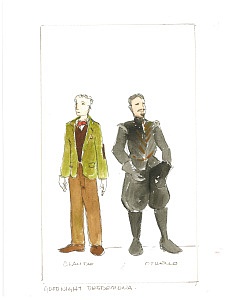
Kelly Wolf’s costume designs for Prof. Claude Knight /Othello, played by Michael Fusillo in the DART production
In the meeting we covered a wide array of topics ranging from questions about Nigel Scott’s set design (which promises to be a good piece of eye candy); to questions about how they are going to pull off the more “science fiction-y” aspects of the show, such as pulling manuscript pages seemingly out of nowhere, or the multiple “warping” scenes in which Constance (Raylene Turner) is transported between different locations and stories. Danielle was open and accommodating, answering all of our questions to the best of her abilities at the time – bearing in mind that this meeting took place nearly four months before opening night, which meant that planning was well underway but still far from completion.
A theme underlying almost every question that we asked was: what drew you to this play? Danielle had a myriad of responses. The first is that Ann-Marie MacDonald is female, Canadian, and contemporary – and what more could you possibly want from a playwright? Another quality that drew Danielle in is that the play speaks to the concepts of equity and equality on many different levels, and covers a lot of feminist concerns. She had been looking for a play that was female-oriented and toyed with the idea of doing Caryl Churchill’s Top Girls, but decided against this because it was in the Shaw Festival’s season last year. In the end, the deciding factor in choosing Desdemona was simply that, after having a long and difficult day, Danielle came home, reread the script, and it made her laugh.
We were able to experience just how the play’s comedy comes to life in our next embedding visit – the first official read-through. In a studio filled with cast and crew members, the six of us were given an “embedding corner” and left to our own devices. Having already established during our original meeting with Danielle that our role within rehearsal settings was that of a “fly on the wall”, we were all very aware of our expectations: to observe, take notes, and enjoy, but not to intervene in the process. Danielle made the environment welcoming and comforting by making sure to include us in the introductions of the cast and crew.
We found ourselves so engaged by the play and the opportunity to hear it spoken for the first time that we almost forgot to take notes! Each of our individual notebooks contains perhaps one page of comments for that session, the majority of which were about how much we enjoyed the script.
Throughout the read-through, we got our first glimpse at Danielle’s directing style with actors. She gave small tidbits of advice every once in a while, such as instructing them to “play the sense of it” and to use the read-through experience as an “opportunity to discover.” Another piece of direction that really stood out was that it was important for the actors not to try too hard to play the comedy, as the script is so inherently funny on its own.
It was clear that the cast was very excited and eager to get further into the rehearsal process, putting a lot of enthusiasm in their voices when delivering their lines. It helped that the actors stood up to read the scenes in which they appeared. The cast in general seemed comfortable with the heightened text of the Shakespearean language that is sometimes featured in the script as well as the colloquial speech, adding to the humour. Their line delivery sounded quite natural and fluid – especially for a first read-through.
A particularly fascinating aspect of this encounter was watching the actors respond to the highly physical nature of the play – as we’ve already established, it involves special effects, and there are also going to be numerous fight scenes. Seeing the actors read their lines and stage directions and half-perform what they thought might be the correct fight movement was thoroughly entertaining. There were many instances in which the actors’ bodies seemed to move instinctually along with the script.
The first couple of visits with the cast and crew of Goodnight Desdemona (Good Morning Juliet) have proven to be exciting and informative. Based on the script alone, this promises to be a show that leaves your stomach hurting and your eyes stinging from laughter; we saw a cast already settling into their roles and a director thoroughly engrossed in the material, committed to putting it on its feet in a dynamic way. This show has the potential to be incredible! In our next post, we will focus on how stage combat plays a role in the show as the rehearsal process unfolds.
Related Posts
What’s the best way to describe Sheila Callaghan’s play Fever/Dream? Simply put by actor Joanna Tran: “like a fever dream.” Director Gyllian Raby...
It’s been a few weeks since the final performance of Brock University Department of Dramatic Arts’ Fall Mainstage, Scenes from an Execution. Closing off their...
What’s the best way to describe Sheila Callaghan’s play Fever/Dream? Simply put by actor Joanna Tran: “like a fever dream.” Director Gyllian Raby...
It’s been a few weeks since the final performance of Brock University Department of Dramatic Arts’ Fall Mainstage, Scenes from an Execution. Closing off their...
Leave a Reply (Cancel Reply)
Twitter Feed
Blogroll
DARTcritics.com is partially funded by the Marilyn I. Walker School of Fine and Performing Arts, in support of student learning; experiential education; student professionalization; public engagement with the teaching, learning and production activities of the Department of Dramatic Arts; new ways of thinking; and the nurturing of links with our communities.

